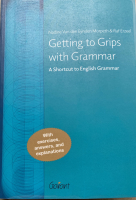- Home
- Book Review Getting to Grips with Grammar
Book Review Getting to Grips with Grammar
20/08/2024 - 17:24
Getting to Grips with Grammar, A Shortcut to English Grammar (2024)
by Nadine Van den Eynden Morpeth and Raf Erzeel (Garant)
Reviewed by Natascha Coene
Getting to Grips with Grammar immediately reminded me of my English linguistics course during the first year of my Germanic philology studies: the same structured explanation of the building blocks of English grammar, accompanied by numerous examples.
This concise grammar guide consists of four parts, followed by exercises and their corresponding keys with explanations. Part one addresses the building blocks of grammar: the different word categories used to form phrases, which in turn are used to form clauses and sentences. This section concludes by introducing the grammatical functions of phrases.
In the second part, the authors discuss the most important word categories. While verbs are included in this discussion, they receive a more detailed treatment in the third section.
The final part focuses on constructing complex sentences. After discussing coordination and subordination, the book highlights relative clauses, as well as nominal and adverbial clauses.
As promised in the introduction, the explanations are kept ‘fairly’ simple. However, readers should be prepared to handle some terminology. Like any grammar guide, the authors have chosen specific terminology; for example, they use the term ‘base’ of a verb, explaining in a footnote that this form is identical to the infinitive, but they do not explain why they opted for this additional term. They also use numerous abbreviations, not only in the explanations but also in titles. So, when ‘GEN-Relatives’ is introduced as a title, readers might appreciate the clear list of abbreviations at the beginning of the book, clarifying that it refers to genitive relative pronouns.
The abundance of examples are a definite advantage of the book. Often inspired by the academic world, these examples are clear and numbered. The numbering system is occasionally used to reference specific examples within the explanations. The schematic overviews are another great aid.
Throughout the explanations, the authors pay attention to differences in pronunciation caused by different endings, concerning plurals, genitives, simple pasts and past participles. The authors have even dedicated some exercises to these differences.
Although the book focuses on British English, it does not ignore the differences with American English. Additionally, the authors acknowledge the dynamic nature of the English language, discussing McDonald’s slogan “I’m loving it” as well.
For students of English, the exercises are very useful. Each unit has a corresponding set of exercises. If necessary, students can immediately refer back to the unit. This might be necessary, for example, with the exercise on the use of imperatives, which was briefly introduced as a kind of mood. Here, the exercise elaborates on the basic explanation of use and negative imperatives by introducing the polite imperative with ‘please’. Some exercises are prefaced by an example. Students can check all their answers in the key, which provides explanations for the answers, sometimes even dealing with different possibilities.
Getting to Grips with Grammar is a useful overview that will help those wanting to learn the basics of English grammar, provided they are prepared to engage with some academic text. Of course, they can skip this part and learn by doing the exercises. The book could also be helpful for educators looking to revise certain grammar topics and find clear examples.
Biography
Nadine Van den Eynden Morpeth is an assistant professor of English at KU Leuven. Her academic career spans nearly four decades and also includes working at the Université Catholique de Louvain and for the University of Limerick (external examiner). Grammar, writing, oral proficiency skills, and business communication are her main areas of expertise. Her work with university students and private clients has given her profound insight into their specific needs in terms of grammar.
Raf Erzeel is a linguist who has recently retired from KU Leuven. He taught English in higher education for nearly forty years, focusing, among other things, on pronunciation, oral proficiency, discourse analysis, translation, and the practical application of grammar. During his long career, he acquired considerable experience in teaching English as a foreign language, taking pleasure in and learning from the interaction with his students.

